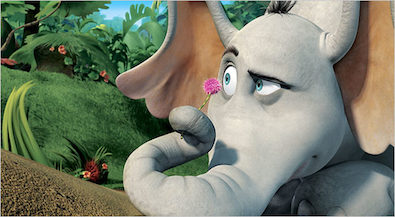The Number One Movie in America: Horton Hears a Who
By Sean Collier
June 18, 2020
BoxOfficeProphets.com

You’d be forgiven for not having noticed. Big-screen adaptations of the classic children’s books are unapologetically all-ages fare, aiming more for multigenerational family outings than the everything-to-everyone approach of studios such as Pixar and Dreamworks Animation. But every one of the five feature adaptations of a Seuss property has been an unquestionable hit.
“The Grinch,” the most recent Seuss adaptation, earned more than $270 million in 2018, finishing 7th for the year. “The Lorax” topped $214 million in 2012, finishing 11th overall. “Horton Hears a Who!” won two weekends and earned $154.5 million, landing in 10th place for 2008. The critically rejected, live-action “Cat in the Hat” was a more modest hit but still crossed the $100 million mark and claimed two weeks atop the box office.
In 2000, the first Suess film — Jim Carrey’s “How the Grinch Stole Christmas” — earned $260 million and won four consecutive weekends. It — not “X-Men,” “Meet the Parents,” a “Mission: Impossible” sequel or “Cast Away” — finished first for the year. That’s not a typo; the weird live-action “Grinch” movie was the number one film of 2000.
It makes a certain amount of sense; parents and grandparents themselves raised on Dr. Seuss can take even the youngest children to visit with characters like the Lorax and Horton. Still, if I had asked you to guess how many Dr. Suess movies became box-office champions, I don’t think you would have guessed “all of them” — if you could even name them.
If you’ve forgotten one altogether, it’s like “Horton Hears a Who!,” the first fully computer-animated Dr. Seuss movie. Released in March of 2008, the adaptation boasted a big-name cast of voice talent — Jim Carrey, Steve Carell, Carol Burnett, Seth Rogen, Amy Poehler and more — but was a bit too middle-of-the-road to leave a lasting impression.
Perhaps the film’s forgettable nature stems from how relatively little happens in the book. That’s true of all Dr. Seuss tomes, of course — there’s not exactly deep conflict in “One Fish, Two Fish, Red Fish, Blue Fish” — but “Horton Hears a Who!” has consistently defied much fleshing out. The 1970 TV special feels long at 26 minutes; the Broadway flop “Seussical” centered itself around the Horton story and had a remarkably short run to thank for it.
The feature film suffers the same fate, attempting to stretch out its central story — Horton believes there’s a world on a passing speck of dust, no one believes him, he is eventually proven right — with a go-nowhere story in tiny Whoville, as the beleaguered mayor tries to connect with his sullen son.
Other than that, it’s pleasant enough; the segments in Horton’s jungle are inventive and frequently funny, and the cast is fully committed if under-utilized. (Poor Carol Burnett shouldn’t have had to leave the house simply to play a kangaroo Karen killjoy.) But it’s lovely and affirming and no doubt certainly engaging enough for young viewers. I’m reminded of the whimsical Dr. Seuss area at Universal’s Orlando theme park — you’re not necessarily going to spend any time there, but you’re happy enough when wandering through it on the way to something else.
“Horton Hears a Who!” is the subject of the latest episode of The Number One Movie in America, a look back at past box-office champions. Each episode’s film is drawn at random from a list of every number-one movie since 1982. Please listen and subscribe!
Next time: a non-Sandler grown-up gets an education.